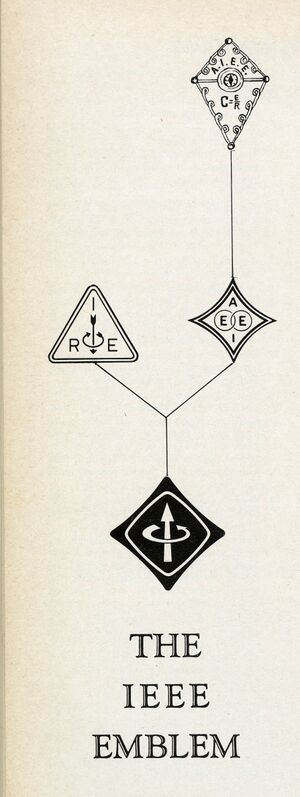Archives:Evolution of the IEEE Logo
The IEEE Emblem
IEEE Student Journal
March 1963, Page 48
The emblem of IEEE will soon make its appearance on college campuses throughout the world as the green and gold badge of Student Members. It is a new emblem, but it embodies a venerable tradition. Its evolution, illustrated above, began nearly 80 years ago.
Representing an organization formed by the consolidation of AIEE and IRE, the emblem of IEEE derives its design from the insignia of the two constituents. However, it is not a mere compound of these two components. Rather, it continues the trend toward an emphasis of basic concepts characteristic not only of the evolution of the emblems of the constituent organizations, but of the whole electrical engineering education and practice. In this, it also conforms to the best modern design and traditional heraldry.
Both the emblems of IRE and AIEE had as a central motif the association of electricity and magnetism, perhaps the most fundamental concept lending itself to graphical representation. In one case, two arrows represent current and magnetomotive force. In the other, linked circles suggest the relation of the electric and magnetic fields. In IEEE, as in its two predecessor organizations, the choice of an emblem was the subject of much careful consideration.
AIEE was founded in 1884. Its first member badge, pictured here, was adopted in 1893 after three years of discussion during which various designs were offered by a committee headed by Dr. Alexander Graham Bell, President of AIEE in 1891-1892. Its outline represented Franklin's kite. Its periphery was marked by an actual coil of gold wire with mid-points spanned by a galvanometer complete with blued steel needle and covered by an amber disc. Thus, it was sought to embody the Wheatstone bridge, the earliest observation of electrical phenomena by Thales, and the source of the word electricity (Amber is elektron in Greek). For good measure, Ohm's law and the letters AIEE were imprinted in gold on the enamel base supporting this remarkable condensation of the history of electrical science. It was abandoned after four years.
In 1897, AIEE adopted the emblem which served essentially unchanged until the merger of 1963. Here the central theme is the linked circles representing the relation of the electric and magnetic fields. The symmetrical outline approximates a hypocycloid of four cusps. It may still suggest a kite and a bridge, but in any event it provides for a balanced distribution of the four initials of the society. The IRE, founded in 1912, as a consolidation of The Society of Wireless Telegraph Engineers and The Wireless Institute, chose the now familiar triangle and arrows representing electrical and magnetic forces in the conventional "right-hand rule" relationship. In choosing as its emblem this fundamental concept, IRE rejected the designs of its predecessor organizations, SWTE and TWI, both of which had used as their insignia the Hertz oscillator and receiver loop. However currently important or historically significant, specific techniques or equipment were wisely judged inadequate symbols for a dynamic organization. The triangular outline of the IRE emblem also provided for a balanced display of three initials.
The IEEE badge then, while new, evolved rationally from its predecessors and retains in its outline and central device readily recognizable features of each. It was proportioned and designed by competent artists. It can be worn with pride in its appearance as well as in the organization it represents. Grades of membership are designated by color. The Student Member badge has a green field with border and central figure of yellow gold. The Affiliate is maroon; Member light blue; Senior Member dark blue. The Fellow badge is yellow gold throughout except for the two arrows which are white gold. New IEEE Student Members will receive the badge upon election. Others may purchase it for $1.00. The emblem of IEEE is protected by registration with the U.S. Government and may be used only by members and in connection with the business of IEEE.
